It's About Time! Automate Biomolecule LC-MS Spectral Deconvolution
By Scott Berger and Patrick Boyce

Since Dr. John Fenn put the “wings on elephants” that described his early work on electrospray mass spectrometry of macromolecules, we have been challenged to identify the most effective means of simplifying the multiply charge spectra that these large molecules generate. From a simple algebraic algorithm that he and his student Matthias Mann first demonstrated in the seminal 1989 protein electrospray mass spectrometry (ESI-MS) paper, to the use of more sophisticated maximum entropy and Bayesian processing algorithms, there have been continued attempts to produce the most accurate and comprehensive deconvoluted zero-charge mass spectra from the electrospray LC-MS analysis of biological macromolecules.
Waters has been progressing intact mass analyses for an equally long time. In John Fenn’s 2002 Nobel Award lecture (John B. Fenn – Nobel Lecture – NobelPrize.org), he acknowledges Brian Green of VG Analytical (a progenitor of Waters Mass Spectrometry), for inspiring the efforts to look at larger molecules, and arranging “for VG to lend us a used quadrupole analyzer that could weigh ions with mass/charge ratios up to 1500” so they could investigate this possibility.
We detail the approach we’ve taken to not only speed up the processing of macromolecule electrospray MS data but to build smarter deconvolution workflows.
Get unlimited access to:
Enter your credentials below to log in. Not yet a member of Cell & Gene? Subscribe today.
